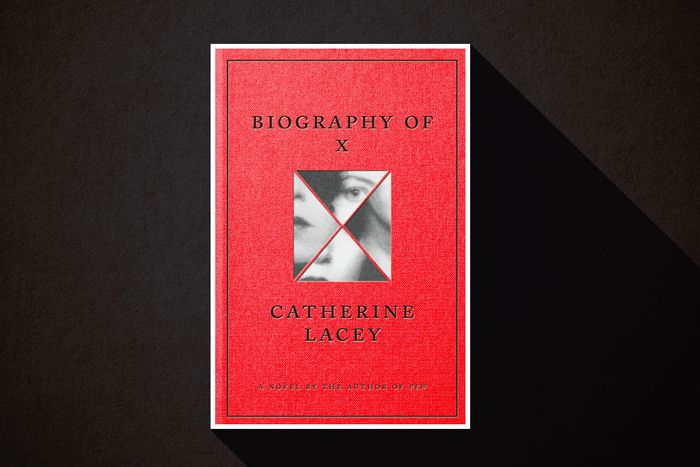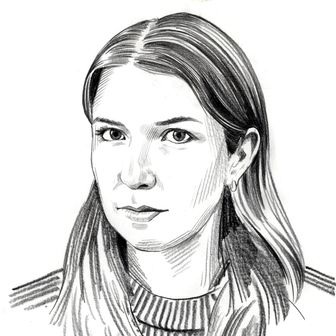
Halfway through the novel Biography of X, the X in question ÔÇö a brilliant performance artist, daring political dissident, and, according to her biographer, kind of a cruel jerk ÔÇö is described by David Byrne as ÔÇ£incapable of returning friendship.ÔÇØ That appraisal, weÔÇÖre told, was printed in a previous biography of the artist. Except at the end of this book-within-a-book, behind a sheaf of gradated pages, an endnote gives the real-life attribution to another Talking Heads member, Tina Weymouth ÔÇö who was describing Byrne.
Catherine LaceyÔÇÖs new high-concept work is full of these kinds of jokingly layered quotations, many of them ventriloquized by X. Through her speak Susan Sontag, Cy Twombly, and Oliver Wendell Holmes, to name just a few. ÔÇ£I wanted to write a real biography of a real person,ÔÇØ Lacey said in an interview last year, ÔÇ£but a teacher of mine encouraged me not to do that, saying it would ruin my life.ÔÇØ Instead, she has put together a real-seeming account of a fake artist. X takes on dozens of personae: a small-press publisher named Martina Riggio, an underground novelist named Cindy O, an imperious artist known only as Vera. XÔÇÖs wife, C.ÔÇëM. Lucca, is the biographer ÔÇö which is to say LaceyÔÇÖs narrator. Their sour love story is woven through an alternate history in which the southern U.S. pulled off a surprise secession in 1945.
The text begins with C.M., freshly widowed, wandering New York and half-heartedly considering throwing herself from a building. She describes herself as seeming plain and glamourless; when X was alive, she felt like both a secretary and a mobsters wife, required by her celebrity spouse to be a neutral administrative presence. Despite this, or because of it, she was unquestioningly devoted to the artist. C.M. left her husband for X, and when they were near each other she felt a sort of buzzing sensation  as if Id just been plugged in. X, meanwhile, was proud, petty, often cold (especially toward C.M.), and remarkable to almost everyone who knew her from Byrne on down. A childhood friend who cries when she remembers X marvels that she could write backward just as quick as she could write forward  even in cursive and everything.
Spite shakes C.M. out of the worst of her grief. A man named Theodore Smith has published a biography of X, and itÔÇÖs clumsily written, full of errors, and ÔÇ£practically radiant with inanity.ÔÇØ It barely punctures the surface of the artistÔÇÖs life. C.M. sets out to write a corrective essay that uncovers her wifeÔÇÖs birthplace and real name, but the project spirals almost immediately. ÔÇ£I did not know that by beginning this research I had doomed myself in a thousand ways,ÔÇØ C.M. writes, and the gradual reveal of what, exactly, could be so horrifying is this narrativeÔÇÖs main thread.
X, C.M. is shocked to learn, was born in the Southern Territory, the portion of the U.S. that splintered off after a far-right Christian overthrow. Until the Reunification in 1996, it was almost impossible for any Southern citizen to escape to the Northern or Western Territories, and the few who did were tracked down to be brought back or killed. X was an exception. ItÔÇÖs a dizzying reorientation for a novel that initially seems to be about the art world. LaceyÔÇÖs alternate America is dense with detail, and we learn about not only the factors leading to the secession (Emma GoldmanÔÇÖs appointment to FDRÔÇÖs cabinet, for one) but also the specifics of, say, a spate of atonic seizures experienced by dozens of women in one Alabama county after the Reunification. In the North, same-sex marriage has long been legal and prisons are nearly abolished.
The Southern Territory and XÔÇÖs perilous escape are a way for Lacey ÔÇö who grew up religious in Mississippi ÔÇö to get at the question of what happens when someone who was raised to believe they live in a world with a god absconds from that world. For all the detail, though, parts of her alternate America feel underrealized. The pages devoted to the Black citizens of the Southern Territory, who face a virulently racist society, pass quickly with a nod to the networks of ÔÇ£unfathomable charityÔÇØ that sustained them. Surely a novel about a South that seceded in 1945 might lend more of its plot to Black communities, and surely the North at that time would have its own intense racism. But those ideas arenÔÇÖt given much narrative priority here.
The side-stepping continues later. Describing XÔÇÖs support of a collective of Black artists, C.M. admits she is ÔÇ£far from an expertÔÇØ on the group, and she directs ÔÇ£those looking for further readingÔÇØ to Black Futures, edited by Jenna Wortham and Kimberly Drew. C.M. says the book was published in 1998; really, it came out in 2020 and is about Black creators more broadly. The gesture seems gracious but nervous, as if Lacey would rather leave that particular tangle of ideas to other authors.
ItÔÇÖs not the only place in the novelÔÇÖs web of citations, names, and quotations that has a constraining effect. After X makes her way to the Northern Territory, she begins a grand tour of 1960s and ÔÇÖ70s America and Europe, exercising a subtle influence over familiar cultural products like an artsy, self-actualized Forrest Gump. She hangs out with Tom Waits at Electric Lady Studios. She goes to West Berlin with David Bowie. She moves to Italy and collaborates with feminist activist Carla Lonzi, and she stalks Sophie Calle for an art piece. In the chapters in which X lives with the cult-favorite songwriter Connie Converse, Lacey inches closest to straightforward biography. At times, itÔÇÖs exhilarating, but the warped cultural history doesnÔÇÖt consistently enhance the plot; at its worst, it feels like a distraction, and the point of it all can be hard to grasp. As X becomes famous for her writing and art, she is interviewed by journalists, many of them presented anachronistically and some imbued with a political life they might not actually have had. The culture writer Durga Chew-Bose, for instance, reports an article about Southern- Territory refugees in 1999 ÔÇö when she would have been 13 in reality. Is this a joke? A wink? Flattery? Are we even supposed to notice Chew-BoseÔÇÖs misplacement in time, or any of the misattributed quotes sprinkled throughout, unless we happen to flip back to those endnotes? ItÔÇÖs unclear.
The chapters in which C.M. makes a reporting trip to the Southern Territory are virtuosic; the material that follows a shift to the New York City art and publishing- worlds, with the egos and press cycles and shallow gallerists and mousy editors, doesnÔÇÖt always gel in the same way. These sections are impressively populated, but, like a real biography, they can start to feel dutiful. Maybe all the actual people whose lives intersect with XÔÇÖs are meant to give us recurring jolts of reality, and maybe LaceyÔÇÖs use of them mimics the artistÔÇÖs identity borrowing. Or perhaps the many prodigies who surround her, the Byrnes and Sontags, are there to convince us of XÔÇÖs genius ÔÇö a solution to that old problem of how an ordinary writer can persuasively portray a brilliant thinker within their novel.
But Lacey herself is brilliant. As in her earlier fiction, she is thinking deeply about what we give up to other people when we love them. Under all the narrative scaffolding, the moments in Biography of X that land most reliably have to do with long-suffering C.M., whose mourning ÔÇö she is ÔÇ£romanced by grief,ÔÇØ she says ÔÇö turns to horror as she unpeels her wifeÔÇÖs layers of secrecy and manipulation. The quandary C.M. faces is something LaceyÔÇÖs been puzzling over from the beginning of her career, and in Biography of X, she has reached a new level of understanding. In her 2018 story ÔÇ£Violations,ÔÇØ a man tries to parse a short story by his ex-wife that may be about him, and The Answers (2006) follows a woman hired to participate in a simulated relationship with a super-celebrity. Here, C.M. has consented to submit to the experiment of love, but sheÔÇÖs only half-informed; much has been concealed from her. The same could be said of us.
More From This Series
- Percival Everett CanÔÇÖt Be Pinned Down
- Haruki Murakami Has Lost the Sauce
- Alan Hollinghurst Tries to Atone



